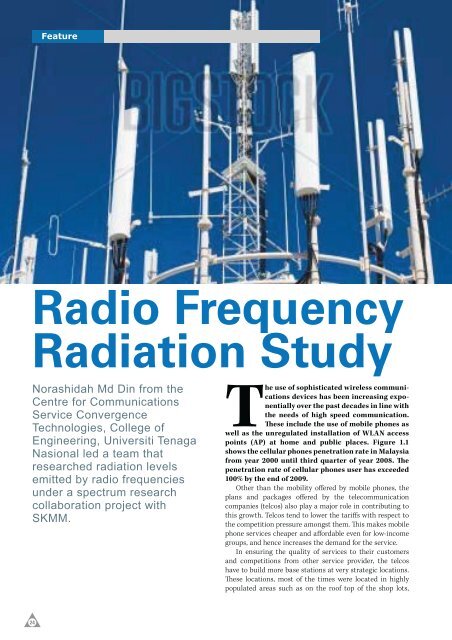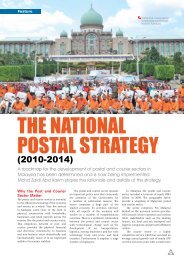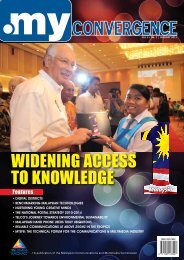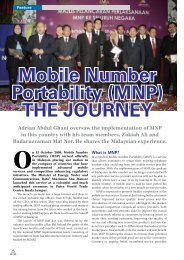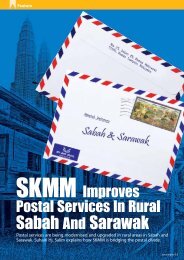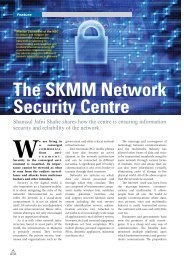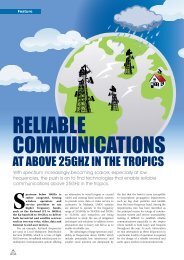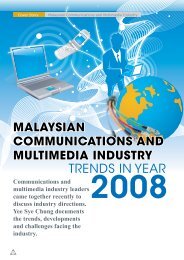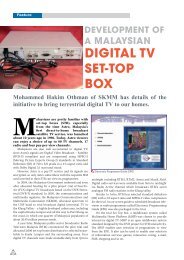download - my Convergence Magazine
download - my Convergence Magazine
download - my Convergence Magazine
You also want an ePaper? Increase the reach of your titles
YUMPU automatically turns print PDFs into web optimized ePapers that Google loves.
Feature<br />
Radio Frequency<br />
Radiation Study<br />
Norashidah Md Din from the<br />
Centre for Communications<br />
Service <strong>Convergence</strong><br />
Technologies, College of<br />
Engineering, Universiti Tenaga<br />
Nasional led a team that<br />
researched radiation levels<br />
emitted by radio frequencies<br />
under a spectrum research<br />
collaboration project with<br />
SKMM.<br />
The use of sophisticated wireless communications<br />
devices has been increasing exponentially<br />
over the past decades in line with<br />
the needs of high speed communication.<br />
These include the use of mobile phones as<br />
well as the unregulated installation of WLAN access<br />
points (AP) at home and public places. Figure 1.1<br />
shows the cellular phones penetration rate in Malaysia<br />
from year 2000 until third quarter of year 2008. The<br />
penetration rate of cellular phones user has exceeded<br />
100% by the end of 2009.<br />
Other than the mobility offered by mobile phones, the<br />
plans and packages offered by the telecommunication<br />
companies (telcos) also play a major role in contributing to<br />
this growth. Telcos tend to lower the tariffs with respect to<br />
the competition pressure amongst them. This makes mobile<br />
phone services cheaper and affordable even for low-income<br />
groups, and hence increases the demand for the service.<br />
In ensuring the quality of services to their customers<br />
and competitions from other service provider, the telcos<br />
have to build more base stations at very strategic locations.<br />
These locations, most of the times were located in highly<br />
populated areas such as on the roof top of the shop lots,<br />
24
Telefon Selular di Malaysia<br />
Cellular Phones in Malaysia<br />
Tahun<br />
2000<br />
2001<br />
2002<br />
2003<br />
2004<br />
2005<br />
2006<br />
2007<br />
2008<br />
Year<br />
Suku<br />
1<br />
2<br />
3<br />
4<br />
1<br />
2<br />
3<br />
Quarter<br />
Pasca<br />
bayar<br />
(000)<br />
2,599<br />
3,069<br />
2,961<br />
2,566<br />
2,555<br />
2,925<br />
3,368<br />
3,392<br />
3,485<br />
3,689<br />
3,905<br />
4,137<br />
4,451<br />
4,926<br />
Postpaid<br />
(’000)<br />
Pra bayar<br />
(000)<br />
2,523<br />
4,316<br />
6,092<br />
8,558<br />
12,057<br />
16,620<br />
16,096<br />
17,427<br />
17,734<br />
18,380<br />
19,442<br />
20,116<br />
20,635<br />
21,236<br />
Prepaid<br />
(’000)<br />
Jumlah<br />
langganan<br />
(000)<br />
5,122<br />
7,385<br />
9,053<br />
11,124<br />
14,611<br />
19,545<br />
19,464<br />
20,819<br />
21,219<br />
22,069<br />
23,347<br />
24,253<br />
25,086<br />
26,162<br />
Total<br />
subscriptions<br />
(’000)<br />
Figure 1.1: Mobile Phone Penetration Rate in Malaysia (Source: SKMM)<br />
apartments or the telcos would build their own base station<br />
towers at the edge of the open space such as playing field<br />
or parking lots of the shopping complexes. The number of<br />
base stations built by telcos in residential areas has raised<br />
concerns from the residents about possible radio wave<br />
effects caused by these base stations to them.<br />
The communication between mobile phones and base<br />
stations involves the exchange of radio signals. The radio link<br />
from the phone to the base station is known as uplink, while<br />
the radio link from the base station to the phone is known<br />
as downlink. The level of these signals is carefully optimised<br />
for the network to perform satisfactorily. The areas covered<br />
by base stations are usually referred to as cells. However,<br />
transmitted signal strength falls off with distance from<br />
base stations, and mobile phones require certain minimum<br />
signal strength to ensure adequate reception. Due to this,<br />
the telcos install more mobile phone base stations to meet<br />
the rapidly increasing demand of mobile phone users. Along<br />
with the increment in the number of base stations is the<br />
public concern on health issues from it.<br />
Several bodies were established internationally to<br />
address these issues. These bodies came out with guidelines<br />
and standards aiming to allay public fear on the effect of<br />
radio frequency radiation. These bodies include International<br />
Commission on Non-Ionizing Radiation Protection<br />
(ICNIRP), Institute of Electrical and Electronics Engineers<br />
(IEEE), the National Radiological Protection Board (NRPB)<br />
in the United Kingdom, Industrial Technology Research<br />
Institute (ITRI) of Taiwan, the Australian Radiation<br />
Kadar<br />
Penembusan<br />
(%)<br />
21.8<br />
30.8<br />
36.9<br />
43.9<br />
56.5<br />
74.1<br />
72.3<br />
77.0<br />
78.2<br />
80.8<br />
85.1<br />
87.9<br />
90.6<br />
93.9<br />
Penetration<br />
Rate<br />
(%)<br />
Protection and Nuclear Safety Agency<br />
(ARPANSA) and many more.<br />
Standardisation And<br />
Exposure Guideline<br />
Different institutions have different<br />
standards in assessing the exposure<br />
levels. These institutions include<br />
ICNIRP and IEEE. Normally, countries<br />
will adopt the standards advised by<br />
these bodies. Figure 1.2 shows standards<br />
adopted by countries around<br />
the world. Most European and Asian<br />
countries adopt the standard set by<br />
ICNIRP. The International Telecommunications<br />
Union (ITU) recommends<br />
the adoption of ICNIRP standards for<br />
countries without such regulations.<br />
ICNIRP Standards<br />
ICNIRP standard is explained in<br />
“Guidelines for Limiting Exposure<br />
to Time-Varying Electric, Magnetic,<br />
and Electromagnetic Fields (up to<br />
300 GHz)”, published in 1998 [5]. The<br />
document aims to establish guidelines<br />
for limiting electromagnetic field<br />
exposure that will provide protection<br />
against known adverse health effects.<br />
Figure 1.3 shows the graph of ICNIRP<br />
standard for both occupational environment and general<br />
public exposure. The maximum exposure limit (MPE) varies<br />
according to the frequency.<br />
The black coloured line illustrates magnetic field limit in<br />
ampere per metre (A/m) and the red coloured line illustrates<br />
electric field limit in volt per metre (V/m). The blue coloured<br />
line illustrates the power density in milliwatts per square<br />
centimetre (mW/cm2).<br />
IEEE Standards<br />
IEEE standards is explained in “IEEE Standard for<br />
Safety Levels with Respect to Human Exposure to Radio<br />
Frequency Electromagnetic Fields, 3 kHz to 300 GHz”,<br />
C95.1-2005 document. The document provides the recommendations<br />
to protect against harmful effects in human<br />
beings exposed to electromagnetic fields in the frequency<br />
range from 3 kHz to 300 GHz, for both the general public<br />
and occupational exposure. Figure 1.4 shows the graph of<br />
IEEE C95.1-2005 standard for general public exposure. The<br />
maximum exposure limit (MPE) also varies according to<br />
the frequency.<br />
The black coloured line illustrates the magnetic field<br />
limit in Ampere per metre (A/m), while the red coloured line<br />
illustrates the electric field limit in Volt per metre (V/m);<br />
and where applicable, the power density limits in watts per<br />
square metre (W/m2) is illustrated in blue line.<br />
IEEE C95.1-2005 standard is a revised version of IEEE<br />
C95.1-1991. Both ICNIRP and the new IEEE standards have<br />
25
100<br />
E-Field(V/m),H Field(A/m),S(W/m²)<br />
E-Field(V/m)<br />
1000<br />
E-Field(V/m),H Field(A/m),S(W/m²)<br />
E-Field(V/m)<br />
10<br />
100<br />
1<br />
S(W/m²)<br />
10<br />
S(W/m²)<br />
H Field(A/m)<br />
1<br />
0.1<br />
0.1<br />
H Field(A/m)<br />
Frequency (MHz)<br />
0.03 0.3 3 30 300 3000 30000 300000<br />
ICNIRP Standards for Occupational and General Public<br />
Frequency (MHz)<br />
0.1 1 10 100 1000 10000 100000<br />
IEEE C95.1-2005 Standards for General Public<br />
relatively small difference, and are identical at frequencies<br />
used in mobile telecommunications systems. The revised<br />
C95.1 standard was harmonised with the ICNIRP standard<br />
in 2005. The process of global harmonisation of RF standards<br />
was supported by the Mobile Manufacturers Forum (MMF)<br />
which will benefit both the consumers and manufacturers<br />
of wireless devices and regulators.<br />
RFR Study In Other Countries<br />
A number of studies have been carried out to study the<br />
amount of Radio Frequency Radiation (RFR) emission from<br />
the Wireless Local Area Network (WLAN) and mobile phone<br />
base stations and to identify potential health risk caused by<br />
RFR from WLAN and mobile phone base stations. Result of<br />
the study carried out by the NRPB at 20 mobile phone base<br />
station sites selected in random from a group of 3000 that<br />
has a low antenna height and radiated low power in United<br />
Kingdom concluded that the members of public would<br />
not be exposed in excess of the ICNIRP guidelines whilst<br />
standing on the ground at any of the sites.<br />
A study carried out by the ARPANSA on the RF electromagnetic<br />
emission (EME) levels in the vicinity of mobile<br />
phone base stations in 14 sites in Australia concluded that<br />
the average RF exposure level from mobile phone base<br />
station was considerably less at 0.0016µW/cm2 as the limit<br />
of power flux density is 200µW/cm2. In Poland, where the<br />
maximum permissible power density value is 0.01 mW/<br />
cm2 at relevant base station frequencies, measurement of<br />
electromagnetic field (EMF) in the surrounds of 20 mobile<br />
phone base stations showed that admissible EMF intensities<br />
at the level of people’s presence, in existing buildings, in<br />
surroundings of base stations and inside the buildings with<br />
antennas, were not exceeded.<br />
A study carried out by the Somerset Scientific Services<br />
to assess the RF exposure level from two WLAN in use at<br />
county schools in the UK indicates that the exposures are<br />
well within the ICNIRP standard. The Office of the Telecommunications<br />
Authority (OFTA) of Hong Kong had carried<br />
out measurements to assess the RF exposure level emitted<br />
by WLAN Access Points (APs) from September 2007 until<br />
October 2008. The report states that the exposure level at<br />
measured locations range from 0.03% to 0.3% of the limits<br />
recommended by ICNIRP.<br />
RFR Study In Malaysia<br />
In Malaysia, several measurements had been carried out<br />
for base stations by the Malaysian Insitute of Nuclear Technology<br />
(MINT) and Universiti Islam Antarabangsa Malaysia<br />
(UIAM). This research complements the measurements<br />
with updated findings for the base station based on the<br />
measurements carried out in year 2008. The RFR emission<br />
for WLAN however, has not been investigated in Malaysia<br />
and our attempt will be the first of its kind.<br />
WLAN Measurements in Kuala Lumpur<br />
and Johor Bahru<br />
The methodology for measuring the RFR from WLAN was<br />
developed based on best practices in ICNIRP and IEEE.<br />
Field measurements were instrumented using broadband<br />
isotropic RF metres positioned at approximate heights of 1<br />
metre and 1.5 metre. RF metre positioning is adjusted within<br />
the location to get the optimum reading. At the maximum<br />
reading spot, Wireless LAN spectrum analyser (WLAN SA)<br />
with antenna was used to span the frequency for WLAN,<br />
i.e. 2.4GHz – 2.5GHz and measurements were recorded for<br />
every 6 minutes up to 24 minutes. Generally, popular locations,<br />
whereby the concentration of Wi-Fi hotspots and users<br />
are high, were selected for RFR measurements. In Kuala<br />
Lumpur’s Golden Triangle, the measurement sites identified<br />
were Suria, KLCC; SOGO, Kuala Lumpur; and Low Yat<br />
Plaza. Measurement sites selected at Johor Bahru were City<br />
Square Johor Bahru, McDonald’s Jalan Skudai, Danga City<br />
Mall, Jaya Jusco Taman Universiti and also The Zon. Based<br />
on the broadband measurements made at the 8 sites, SOGO<br />
was found to have the highest recorded WLAN radiation<br />
in the area with electric field strength of 0.00303 µW/cm2<br />
in Kuala Lumpur. Whereas, McDonald’s Jalan Skudai was<br />
found to have the highest recorded WLAN radiation in the<br />
area with electric field strength of 1.015 µW/cm2 at Johor<br />
Bahru. When compared, the highest recorded reading made<br />
during the study was far below the MPE standard set by the<br />
international bodies like ICNIRP, i.e. 0.2mW/cm2.<br />
26
Antennas(10m above ground)<br />
shophouses<br />
TNB<br />
Building<br />
1<br />
big tree<br />
10m<br />
2<br />
3<br />
4<br />
5<br />
road<br />
playground<br />
A<br />
B<br />
slides<br />
C<br />
D<br />
3m<br />
3m<br />
E<br />
F<br />
One of the sites and measurement grid points made of the site<br />
Legend:<br />
X - Measurement points 3m from each other<br />
Base Station Measurements in Kuala Lumpur<br />
and Johor Bahru<br />
RFR from base stations measurement methodology was also<br />
developed based on best practices from other countries and<br />
institutions such as ICNIRP and IEEE. Measurements were<br />
conducted using broadband isotropic RF metre at height of<br />
1.5 m above ground level, which is about the height of an<br />
average human and the electric field strength metre was<br />
set to max-hold mode for six minutes. The results were then<br />
compared to the lowest maximum permissible exposure set<br />
by ICNIRP (0.2 mW/cm2) to emulate worst case scenario.<br />
Narrowband measurements were carried using Advantest<br />
U3741 spectrum analyser when the reading at a point<br />
exceeds 0.2 mW/cm2 or at the point that gives the highest<br />
reading at the each site.<br />
A total of ten sites, five located in Kuala Lumpur and<br />
another five in Johor Bahru, were selected for measurement.<br />
Base stations identified at Kuala Lumpur were at Wisma<br />
Lim Foo Yong, Lorong Datuk Sulaiman, Jalan Pandan Indah,<br />
Jalan Wangsa Murni and Jalan Pandan Ilmu. Base sations<br />
identified at Johor Bahru were at Jalan Kuching, Restoran<br />
Taat, Johor Tourist Information Center, Jalan Wong Ah<br />
Fook and Hotel A. The highest recorded reading using the<br />
broadband measurement was at Hotel A, which is 0.004331<br />
mW/cm2. The results show that the radiation levels for all 10<br />
sites are below the maximum permissible exposure set by<br />
ICNIRP of 0.2mW/cm2.<br />
Health Concerns<br />
New telecommunications technologies have been introduced<br />
without full provision of information about their<br />
nature and without prior discussion within the scientific<br />
community about possible consequences for health. The<br />
average output power from the antennas of digital mobile<br />
phones is lower than that from earlier analogue models,<br />
but the maximum powers are greater, the exact patterns of<br />
radiation are different and these differences might influence<br />
their effects on people. As the costs of mobile phone technology<br />
have fallen, their use has increased dramatically and<br />
the overall levels of exposure of the population as a whole<br />
have therefore increased.<br />
Radiofrequency radiation from wireless communications<br />
facilities has become a large public health concern in<br />
many countries of the world. People are not only concerned<br />
about the growing weight of scientific evidence linking<br />
health effects to mobile phone use, they are increasingly<br />
worried about chronic, low-level exposure to base stations<br />
or cell sites.<br />
In the last 40 years, there are numerous studies on health<br />
effects caused by electromagnetic energy (EME) radiated<br />
by mobile phones, base stations and other RF transmitters.<br />
These health effects can be divided into two: thermal and<br />
non-thermal effects. Several factors have been taken into<br />
account in the studies on health effects by EME sources such<br />
as the level of exposure (i.e. power density), frequency and<br />
the duration of exposure (short and long term exposure).<br />
Lab tests were carried out on animals such as rats,<br />
rabbits, dogs, guinea pigs, etc. The animals were exposed to<br />
various factors as stated above. Among the effects studied<br />
were hyperthermia and gross thermal effects, effects on the<br />
eyes, endocrine and nervous system, effects on reproduction<br />
and development and so forth.<br />
As for the effects on human, studies were carried out on<br />
personnel involved in installing, maintaining and repairing<br />
RF devices. Among the effects studied were possible effects<br />
on the eyes, effects on reproduction and development and<br />
cardiovascular effects. Weak non-ionizing radiation, such<br />
as that from mobile phones, mobile phone base stations and<br />
Wi-Fi has been shown to have biological effects, ranging<br />
from changes in brain function to the exacerbation of<br />
allergies and the induction and promotion of cancer.<br />
A number of scientific studies have investigated possible<br />
health effects of mobile phone radiations. These studies<br />
are collected and reviewed by scientific committees at<br />
the World Health Organisation (WHO), ICNIRP and other<br />
27
similar bodies to assess the overall risks. Most of the assessments<br />
conclude that, from the available research, there are<br />
no significant health effects that have been demonstrated<br />
from mobile phone radiation at normal exposure levels.<br />
However, there are scientific evidence for mobile phone,<br />
mobile base stations and WLAN causing biological effects<br />
and potentially can become health hazards for the public.<br />
In the year 2000, World Health Organization (WHO)<br />
recommended that the precautionary principle could be<br />
voluntarily adopted in this case. It follows the recommendations<br />
of the European Community for environmental risks.<br />
Precautionary principle is a risk management policy applied<br />
in circumstances with a high degree of scientific uncertainty,<br />
reflecting the need to take action for a potentially serious risk<br />
without awaiting the results of scientific research. Other less<br />
stringent recommended approaches are prudent avoidance<br />
principle and ALARA (As Low as Reasonably Achievable).<br />
Although all of these are problematic in application, due to<br />
the widespread use and economic importance of wireless<br />
telecommunication systems in modern civilisation, there<br />
is an increased popularity of such measures in the general<br />
public, though also evidence that such approaches may<br />
increase concern. Recommendations include minimisation<br />
of cellphone usage, the limitation of use by at-risk population<br />
(children), the adoption of cellphones and microcells<br />
with ALARA levels of radiation, the wider use of hands-free<br />
and earphone technologies such as Bluetooth headsets,<br />
the adoption of maximal standards of exposure, RF field<br />
intensity and distance of base stations antennas from<br />
human habitations.<br />
After 10 years of surveillance and study, in May 2006,<br />
the World Health Organization (WHO) issued Fact Sheet<br />
No. 304 under the Electromagnetic Fields and Public Health,<br />
entitled Base Stations and Wireless Technologies. Among<br />
others, the fact sheet stated that:<br />
• Recent surveys indicate that RF exposures from base<br />
stations are between 0.002% to 2% of the international<br />
standards.<br />
• RF exposures from base stations are lower or comparable<br />
to RF exposures from radio and television broadcast<br />
transmitters.<br />
• Because of the low frequency of radio (around 100 MHz)<br />
and television (300-400 MHz), human body absorbs up<br />
to 5 times more of these signal than from base stations.<br />
In addition, radio and television broadcast have been<br />
in operation for the past 50 or more years without any<br />
adverse health consequence being established.<br />
• A common concern about base stations and local<br />
wireless network relates to the possible long-term health<br />
effects that whole body exposure may have.<br />
As for the link to cancer, the fact sheet stated that<br />
geographically, cancers are unevenly distributed among<br />
any population. Given the widespread presence of base<br />
stations in the environment, it is expected that possible<br />
cancer clusters will occur near base stations by chance.<br />
Moreover, cancers cases reported in these clusters are often<br />
a collection of different type of cancer with no common<br />
characteristics and hence are unlikely to have a common<br />
cause. Studies examining a potential relationship between<br />
RF transmitters and cancer published over the past 15 years<br />
have not provided evidence that RF exposures increase the<br />
risk of cancer. Likewise, long term animal studies have not<br />
established an increase risk of cancer from exposure to RF<br />
fields, even at values higher than those produced by base<br />
stations and wireless networks.<br />
Studies have also been conducted on Electromagnetic<br />
Hypersensitivity (EHS) individuals as described in WHO<br />
Fact Sheet No 296 which was published in December 2005.<br />
EHS individuals are individuals who experience nonspecific<br />
symptoms upon exposure to RF Fields emitted by<br />
base station and other wireless transmitters. The aim of<br />
these studies was to bring forth symptoms under controlled<br />
laboratory conditions. For example, a study involving fifteen<br />
EHS individuals and normal controls exposed to electric<br />
and magnetic fields in their homes or workplaces was<br />
conducted. The result shows that EHS individuals were no<br />
better than control subjects in identifying their exposure to<br />
electric or magnetic fields during the experiment.<br />
Conclusions<br />
The era of pervasive and ubiquitous communications is<br />
inevitably coming and is very much dependent on wireless<br />
communications through radio frequency radiation. It<br />
is recommended that random audits be done regularly to<br />
ensure that the wireless communications environment<br />
conforms to international safety levels. The radio frequency<br />
radiation readings recorded for selected WLAN and base<br />
stations sites in KL and JB in our study were found to be far<br />
below the international service safety level.<br />
End Note: Md Zaini Jamaludin, Nagaletchumi Balasubramaniam,<br />
Aiman Ismail and Thahirah Syed Jalal were in the<br />
team that carried out the study<br />
Associate Professor Dr. Norashidah Md Din is<br />
Head of Department,<br />
Dept. of Electronics and Communication Engineering,<br />
Universiti Tenaga Nasional.<br />
She can be reached at<br />
norashidah@uniten.edu.<strong>my</strong><br />
28


